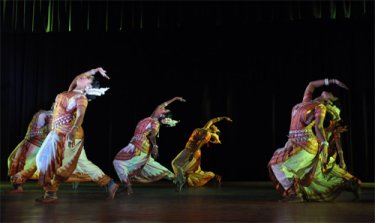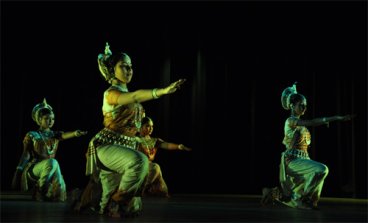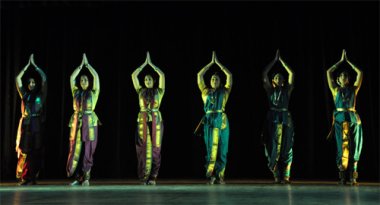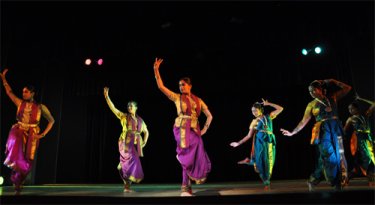
|   |

|   |
The 8th edition of the Sangam Festival - Lalitha Venkat, Chennai e-mail: lalvenkat@yahoo.com Photos: Ganesh September 18, 2012 Art Vision, founded in 1996 by Ileana Citaristi with a group of artistes belonging to different disciplines, presented its eighth edition of the Sangam Festival, a confluence of dance, on September 12 at Rabindra Mandap, Bhubaneswar. With concept and choreography in the Odissi style by Ileana Citaristi, a prime disciple of Guru Kelucharan Mohapatra, ‘Kaala – Time Bound’ depicted time as it travels through different phases. For every Sangam Fest, Ileana always premieres a new production, and it is well timed for this month since her artistes are also relatively free from stress of academic work. The inspiration for this production was an installation art conceived by Kapila Vatsyayan for IGNCA that Ileana had seen about ten years ago but the idea came to fruit only this year. The underlying theme is that anything that’s born has to die. 

‘Kaala – Time Bound’
The abstract theme depicted time as it travels through different phases,
from unmanifested time to the first pulsation (spandan) to organic
life. Starting on a meditative note, the next segment had the dancers
perform in a ray like formation to lines from the Vedas. “From the
mighty Creator were born the waters or atoms. From Him came the Vedic
lore or Brahmand, the heating fire and the quarters. The sun rises
because of His power and in Him does it set again. The wind blows by his
force. The great earth rotates and revolves through His energy. The
vast heavens rest in Him.” Movement of time was depicted as movement
along geometrical lines: linear lines, circles, square and triangle.
After the void comes the tremor. Time was conceived as an arrow which
travels through past, present and future, the dancers moving along
diagonal parallel lines. Sacred time travels in a circular path, the
path of myths and of eternal return (kaala chakra). The dancers formed
and unformed circle patterns, breaking into four dancers for the square
and three for the triangle. Here, Ileana has used Kathak like rhythms in
beats of 9, 11 and 13. Seasons come and go, giving some and taking some. People come and go. Nothing remains. In this transformation, time is sometimes peaceful and auspicious, sometimes cruel, so good times turn into bad times. The music is broken here by a brief English and Oriya dialogue (Where’s the time? Give me some time. There’s no time. It’s a waste of time!) that does not quite fit into the music score. Here, Ileana had the dancers in profile, an “inspiration by a work of Nijinsky and as is also seen in images on ancient Greek pottery.” Time devours what he has created in the eternal cycle of creation and destruction. The sky trembles and Lord Shiva dances the tandava. Saswat Joshi as Shiva was impressive. But in the darkness there is a ray of light. This is symbolized by, “Above every commotion, a lamp is burning steady without flickering in the sanctum sanctorum.” The meditative movements flow into the last story of a swan that finds its eternal home in the celestial Lake Manasarovar, tempted no more to fly off elsewhere. To live in the now, man has to reach a state of transience, a state of timelessness. The Odissi movements with touch of Chhau were effective with balanced slow and fast paced segments. Music was an asset to the production. With lyrics by Devdas Chhotray, music was composed by talented Bangalore based flautist and vocalist Annada Prasanna Patnaik. Rhythm was by Sachidananda Das and the aesthetic lighting effects by Lalthendu Panigrahi. The talented dancers were Sagarika Mohanty, Geethanjali Mohapatra, Sunita Maharana, Pallavi Beriha, Anindita Parida, Upasana Mohanty, Mousimi Mohapatra, Rashmi Rekha Das (who had only a week to learn her part as substitute for an injured Ileana), and the only male dancer Saswat Joshi. Says Ileana about her new work, “After a couple of years of doing traditional work I went back to an abstract theme. It was a challenge because it requires ideas and inputs from me about what to put into the lyrics and fortunately, Devdas used simple language without getting too wordy. This suits the dance so well. It also helped that the music composer is from Odisha, so there was no problem in pronunciation of the lyrics.” 

‘Ardhanariswara’
The second performance of the evening by Kalavardhini Sankul, Pune, in Bharatanatyam style was titled ‘Ardhanariswara’. There were 6 dancers with three representing male and three representing female identity, the choreography made to highlight “the manliness in every woman and a touch of womanhood in every man” through interpretative as well as pure rhythm movements. After a stotra by Shankaracharya, the next item focused on Devi, her compassionate beauty that evokes awe in the minds of the devotees. The ananda tandava of Shiva was followed by the concluding item ‘Ardhanariswara’ as a thillana representing both the male and female aspects. The concept by Sucheta Bhide-Chapekar was transformed into choreography by Arundhati Patwardhan. The well versed dancers were Arundati Patwardhan, Rama Kuknur, Yashoda Patankar, Avni Joglekar, Manasi Jog and Shubangi Litke. The uneven quality of the music recording let them down in places. The evening also saw the release of Ileana Citaristi’s book ‘Traditional martial practices in Odisha’ published by Subhi Publications, Delhi. It was supposed to have been released by the Odisha minister of Tourism and Culture but in the event of his not turning up (resulting in a half hour delay in commencement of the evening’s program), it was released by dignitaries present after the first performance. “I owe it to the Paiko artistes, who have helped me so much in my documenting work. The real culture and life are in the villages. This book is to highlight their history, survival, and contribution to Odisha,” said Ileana. The cheerful, bubbly compere of the evening was a disaster with her wrong pronunciations and needless chatter! Lalitha Venkat is the content editor of narthaki.com |